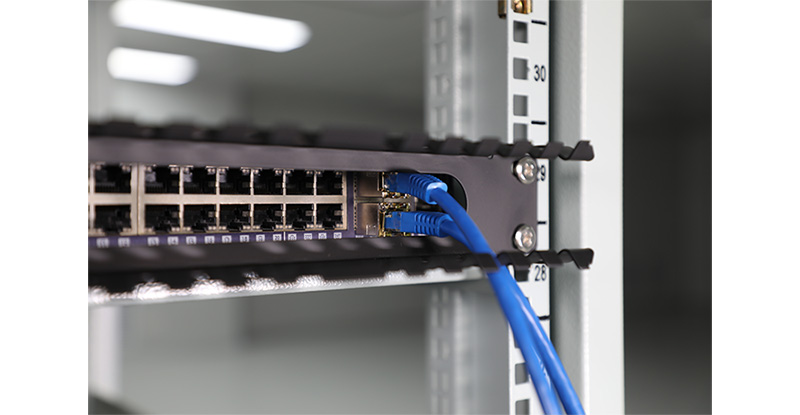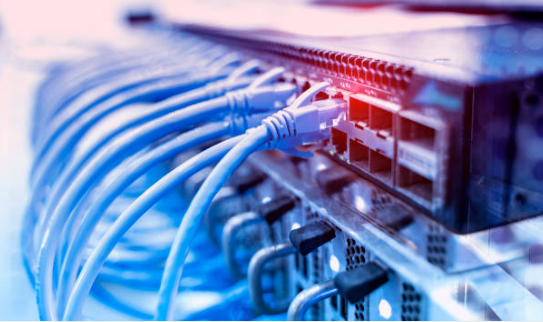What is Cat 7 Ethernet Cable and Are Cat7 Cables Worth It?
What is Cat7 Ethernet Cable?
Cat7 (Category 7) cable, a shielded twisted pair cable specified in ISO/IEC 11801:2002, Class F, is introduced to support 10 Gigabit Ethernet of distance up to 100m over copper cabling. It is also known as Class F cable and is backward compatible with Class D Cat5, Cat5e, and Class E Cat6 cabling standards and equipment. However, Cat 7 Ethernet cable is not an IEEE Ethernet standard and is not recognized by TIA and EIA. Cat7 cable is compliant with 10/100/1000BASE-T, 10GBASE-T Ethernet, and Power over Ethernet (PoE). It is mostly used in data centers, server rooms, and telecom rooms to provide high-frequency point-to-point Ethernet copper connections between servers, switches, and computers.
Cat 7 Connector and Shielding Type
Cat 7 cable consists of 4 tightly twisted copper wire pairs and adopts an S/FTP (Shielded Foil Twisted Pair) shielding method. S/FTP adopts a dual shielding design: each of the four twisted pairs is individually shielded with a foil wrapping, then the cable bundle as a whole is wrapped in a screen-shielded or screen-foil layer. This advanced shielding type can protect the cable from electromagnetic interference (EMI) and alien crosstalk (AXT) at the highest level. Cat7 cable is terminated with GG45 or TERA connector, providing a frequency of up to 600 MHz. Note: in a real lab test, Cat7 may get higher bandwidth in short reach.
Cat 7 Cable Specification
The Cat7 network cable parameters may be slightly different from vendor to vendor. The following Cat 7 specs are from one of our partners. One thing to note here is: in the light of Cat 7 speed and shielding method, Cat6a is a comparable choice. However, as the Cat7 sounds to be newer, it is difficult to market Cat6a. Therefore many companies begin to sell Cat6a cable by naming it Cat7. So for customers who need real Cat7 cables, be noted to check the exact specification before making a choice.
Cat 7 Patch Cable vs Cat 7 Cable Bulk
The Ethernet patch cable is the copper Ethernet cable that we commonly used in daily life, such as connecting the desktop to the server. It is often a pre-terminated copper cable within 100 meters. The bulk Ethernet cable is a long Ethernet cable spool, typically seen as 500ft and 1000ft. For example, the Cat7 patch cable is a short cable with a connector on each side. The Cat7 bulk cable is a roll of pure copper cables without connectors on either end. The common types are Cat7 500ft and Cat7 1000ft.

Cat 7 vs Cat 7a
Cat7a refers to as “Category 7 Enhanced”, is the advanced version of Cat7, It is also known as Class F advanced (Fa) cable. The Cat 7a Ethernet cable almost doubles the frequency of Cat7 to 1000MHz. However, the max data rate of the Cat 7a cable is still at 10Gbps.
Cat 7 vs Cat 8
In terms of performance, the Category 8 cable has two enhancements compared to the Category 7 cable. First and foremost, Cat8 is designed for high-speed Ethernet networks to rate up to 25GBASE-T (Cat8.1) or 40GBASE-T (Cat8.2), which is a great leap. Second, Cat 8 cable supports frequencies up to 2000MHz, which is twice and even more than that of the Cat7 Ethernet cable. However, the max transmission distance beyond 10GBASE-T is limited, usually within 30 meters.
Cat6 vs Cat7
Cat 6a and Cat 7 cables are quite similar in several features. They are both composed of four twisted pair wires, support 10GBASE-T Ethernet with a max distance of up to 100m and Cat6a and Cat7 provide almost the same frequencies.
Though Category 7 cable was the firstborn to support 10 Gbps over 100m in 2002, The later developed version of Cat6 (Cat6a) in 2008 makes the capability not special anymore. The Cat6 cable can also provide 10G-T over 100m.
Cat 5e vs Cat 7
Cat7 and Cat7a cable structures are more complex than Cat5, so the manufacturing cost is higher. The cable is stiffer than Cat5. Cat5e is UTP, with little tolerance to interference. Cat7 is S/FTP, providing a more stable signal quality. Cat7 provides six of the frequency of Cat5e, and Cat7a tenfold the bandwidth to 1000MHz.
Cat5e vs Cat6 vs Cat7 vs Cat8 Contrast Table
Considering Cat 7 cable price, there is not much difference compared to the former categories. Even Cat8 patch cables only cost slightly higher.
For Cat 7 PoE capability, most modern Ethernet cable vendors will converge the Power over Ethernet compatibility into manufacturing. Cat5e, Cat6/6a, Cat7, and Cat8 cables all support IEEE 802.3af/at/bt standards to meet PoE/PoE+/PoE++ applications.
Take the prices of different categories 3 feet (0.9 meters) Ethernet patch cables below for reference.
Are Cat7 Cables Worth It?
Some may ask questions like: are Cat7 cables worth it? Is Cat7 good? This issue is dialectical. Several features make Cat7 unique, however, there are some reasons why Cat7 is not as widely adopted as Cat6a or not more feasible than Cat8.
Given that Cat7 is double shielded, it has advanced performance against EMI and crosstalk and achieves higher bandwidth. It has a long overall lifespan of 15 years.
What prevents Cat7 to be popular are the connector minority and its unapproved by the Ethernet standard authority IEEE/EIA. While the priors cables such as Cat6a and the new-gen Cat8 are using 8P8C RJ45 connectors, mainstream system equipment providers are focused on developing hardware with an RJ45 interface, leaving the Cat 7 cable (using Cat7 GG45 Connector) with no acceptance for direct connection to servers and switches.
Though Cat8 is also not approved by IEE/EIA, it does utilize the RJ45 connector, which is flexible to use in direct connection. Besides, there are no advantages regarding Cat 7 speed and Cat7 frequency. Unprecedentedly the Cat8 supports a data rate beyond 10Gbps to 25Gbps and 40Gbps, and higher frequency up to 2000MHz, making it a more future-proofing solution for high-bandwidth Ethernet and demanding applications.
Additionally, the shielding benefits that Cat7 and Cat7a own are shared by Cat6a and Cat8. Though Cat7 and Cat7a raise the frequency, the Cat 7 max speed at 10G is identical to Cat6a.
Move to 10G-T with QT SFP-10G-T over Cat6a or Cat7
QSFPTEK-manufactured SFP-10G-T transceivers can use together with Cat6a and Cat 7 cables to achieve a full 10GBASE-T speed over 30m. An advanced version of SFP-10G-T-80 will extend the 10G rate over 80m. They also support intermediate 2.5GBASE-T and 5GBASE-T, flexible for NBASE-T end-pints connections. Further, if your existing copper cabling infrastructures are based on Cat6a cables, deploying the 10GBASE-T SFP+ module will let you seamlessly migrate to 10G access without extra upgrading expense.

Last Word
Generally speaking, the current copper Ethernet is still dominated by Category 5e/6/6a cables. Category 7 cable applications are limited to demanding application scenarios, such as high-performance data center switch-to-switch interconnects. For users who are considering shopping for Cat7 Ethernet cables, then the essential choice is mainly between Cat6a vs Cat7 vs Cat8. Considering future-proofing capability and always keeping up with the highest frequency, the Cat8 cable is your choice to go. If 10GBASE-T is just what you want to access, and in ten years migration to 25G or 40G is not required, the Cat6a cable might be the better choice than Cat7.
Consulting any issues on Cat7 or optical transceivers for matching with Ethernet cables, please go to [email protected] for support.











